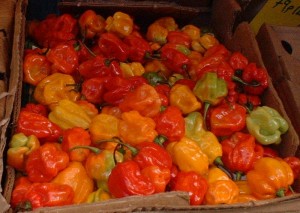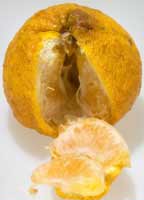This page includes: Culinary traditions, Unusual ingredients, Classic dishes, For the meek, For the bold, and For the digestively challenged.
A word to the wise: Your digestive system may not be accustomed to foreign microbes. If you want to try local fruits or vegetables, prudence suggests that you make sure you wash them thoroughly or buy them at an upscale restaurant that’s used to catering to the delicate constitutions of tourists.
Culinary traditions
Jamaica is 4,200 square miles (roughly the size of Connecticut), with about 630 miles of coastline. Fish and goats figure prominently in the cuisine, as do tropical fruits and vegetables. Only 16% of the land is suitable for raising grains such as wheat and corn, so these are not staples of the diet.
In the 16th century the Spanish began importing slaves, who preserved African cooking techniques. Jews migrating from Spain brought escoveitch and other favorite dishes. When the English took control of Jamaica in 1655, they brought culinary novelties such as the patty, a turnover filled with spicy meat. The Chinese and East Indians who arrived as indentured laborers in the 19th century, after the slaves were emancipated, brought curried dishes that remain popular throughout the island.
Ingredients
Ackee: red fruit with yellow flesh and three black seeds, used in the popular breakfast dish ackee and saltfish. When cooked, ackees have the texture and flavor of soft-boiled egg yolks.

Blue Marlin: firm-fleshed fish, somewhat sharper than salmon. Can be cooked as steaks or smoked.
Breadfruit: large, green fruit with starchy flesh.

Cassava (a.k.a. yucca, tapioca, manioc and manihot): a starchy root vegetable.
Callaloo (a.k.a. Chinese spinach or Indian kale): leafy, spinach-like vegetable, usually steamed, like turnip or collard greens.
Chicken: has distinctive flavor due to diet
Conch: the giant mollusk in whose shell you can hear the sea. The rather tough flesh has to be beaten, ground, or tenderized by soaking in lime juice.
Janga: crayfish (shrimp), sold hot, salted, and peppered at roadside stands
Lobster: the spiny or Caribbean variety, which differs from Maine lobsters in the texture of the flesh and its lack of claws.

Pickapeppa Sauce (a.k.a. Parrot Sauce, from the bird on the label): combination of tamarind, onions, tomatoes, sugar, cane vinegar, mangoes, raisins, and spices, produced since 1921 for use on meat, fish, eggs, etc.
Pimento: known elsewhere as allspice, because it seems to combine the flavors of cinnamon, nutmeg and clove. Pimento is used in jerk marinade, and the wood of the tree on which it grows is used in cooking jerk. Jamaica produces most of the world’s supply of allspice.
Plaintain: a non-sweet member of the banana family, served as appetizer or starchy side dish; it’s inedible raw.
Saltfish: any salted fish, but usually cod. Part of the typical Jamaican breakfast dish ackee and saltfish. In Spain and Portugal, it’s known as bacalao.
Scotch bonnet pepper: small, very hot pepper related to the habanero; can be green, red, yellow or orange. The spiciness of a dish with these in it depends on whether they were chopped and added into it, cooked in the water, etc.

Ugli fruit: mottled greenish-yellow citrus fruit that looks like a cross between a pear and a grapefruit and has a sweet, citrusy taste.

Classic dishes
Ackee and Saltfish: popular breakfast dish of (duh!) saltfish and ackee.
Bammy: ground cassava mixed with coconut milk and fried. Looks like a pancake.
Bulla: a bun with nutmeg, cinnamon and brown sugar.
Coco Bun: yeast bread, best eaten right out of the oven.
Cowcod Soup: includes bananas, pepper and white rum; usually sold at roadside stands. Famous as an aphrodisiac.
Curried Goat: marinated in onion, garlic, and Scotch bonnet peppers, then simmered with curry.
Escoveitch, escovich, escabeche (from the Spanish word for “pickled”): cold dish of fried fish pickled in vinegar, spices, Scotch bonnet peppers, and oil.
Festival: cornmeal bread with nutmeg and lime juice; similar to hush puppies.
Fish Tea: a spicy soup, fish cooked with green bananas, a Scotch bonnet pepper, scallion, garlic, and potatoes. Watch out for bones.
Jerk: pork, chicken or fish marinated with some combination of ginger, pimento, cinnamon, nutmeg, pepper, Scotch bonnet peppers, scallion, and thyme. This is the most popular dish in Jamaica and one of the earliest known; Columbus described it being made by the Tainos Indians ca. 1500.
Patty: turnover filled with meat or vegetables that are seasoned with onion, Scotch bonnet peppers, curry, thyme, etc. A lunchtime favorite.
Rice and peas: rice and beans (not peas!) cooked in coconut milk and seasoned with onion, garlic and Scotch bonnet pepper.
Rundown: pickled fish cooked in seasoned coconut milk with onion, tomato and Scotch bonnet pepper until the fish falls apart.
Solomon Gundy: paté (a cold spread) of pickled fish with vinegar, oil, onion, and Scotch bonnet pepper, served on crackers as an appetizer.
Soursop ice cream: coconut milk (rather than milk or cream), flavored with the tropical fruit soursop.
Stamp and Go: spicy hot fritters, usually saltfish with garlic, onion, tomato, and Scotch bonnet pepper.
For the meek
Grouper: mild taste; served fried, broiled, etc. in almost every restaurant.
Blue Marlin: mild, but check the menu description for spices.
For the bold
Jerk: the spiciest you can find; ask a native where to go for it.
Mannish water: spicy soup with goat’s head (sometimes tripe and feet, too), garlic, scallion, cho-cho, green bananas, Scotch bonnet peppers, and dumplings (white rum is optional); known as an aphrodisiac.
Stinking Toe: pod that resembles a human toe and has an smelly, rough exterior. The sugary powder inside can be eaten raw or used to flavor custards or beverages.
For the digestively challenged
Low carb or diabetic: curried goat, janga, escoveitch, jerk, rundown, stamp and go.
Low fat: janga, escoveitch, rundown, stamp and go.
Vegetarians: I-tal (EYE-tal) food, the cuisine of the Rastafarians, focuses on ingredients that are as pure as possible, unpreserved and often uncooked. Forbidden ingredients include meat (especially pork), coffee, salt, and seafood (except small fish). Look for Rasta flag (red, green, and gold in horizontal bands) on I-tal restaurants. Among the Classics above, try Rice and Peas.